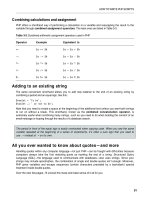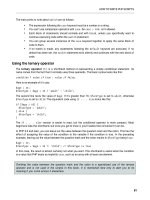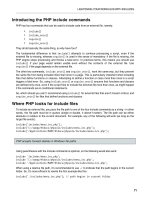Giải pháp thiết kế web động với PHP - p 2 pdf
Bạn đang xem bản rút gọn của tài liệu. Xem và tải ngay bản đầy đủ của tài liệu tại đây (435.83 KB, 10 trang )
CONTENTS
ix
Breaking down information into small chunks 283
Checkpoints for good database design 284
Using MySQL with a graphical interface 284
Launching phpMyAdmin 286
Setting up the phpsols da tabase 287
MySQL naming rules 287
Using phpMyAdmin to create a new database 288
Creating database-specific user accounts 288
Creating a database table 291
Inserting records into a table 293
Creating a SQL file for backup and data transfer 297
Choosing the right data type in MySQL 299
Storing text 299
Storing numbers 300
Storing dates and times 300
Storing predefined lists 301
Storing binary data 301
Chapter review 301
Chapter 11: Connecting to MySQL with PHP and SQL 303
Checking your remote server setup 304
How PHP communicates with MySQL 305
Connecting with the MySQL Improved extension 305
Connecting with PDO 305
PHP Solution 11-1: Making a reusable database connector 306
Finding the number of results from a query 307
Displaying the results of a query 310
MySQL connection crib sheet 313
Using SQL to interac t with a da tabase 314
Writing SQL queries 314
Refining the data retrieved by a SELECT query 315
Understanding the danger of SQL injection 319
Chapter review 334
CONTENTS
x
Chapter 12: Creating a Dynamic Online Gallery . 335
Why not store images in a database? 336
Planning the gallery 336
Converting the gallery elements to PHP . 339
Building the dynamic elements . 341
Passing information through a query string. 341
Creating a multicolumn table . 344
Paging through a long set of records 347
Chapter review 353
Chapter 13: Managing Content. 355
Setting up a content management system . 355
Creating the blog database table 356
Creating the basic insert and update form. 357
Inserting new records . 359
Linking to the update and delete pages 363
Updating records 366
Deleting records . 375
Reviewing the four essential SQL commands . 376
SELECT 377
INSERT . 379
UPDATE 380
DELETE 380
Security and error messages . 380
Chapter review 381
Chapter 14: Formatting Text and Dates 383
Displaying a text extract . 383
Extracting a fixed number of characters . 384
Ending an extract on a complete word 385
Extracting the first paragraph . 385
Extracting complete sentences 387
Lets make a date 390
How MySQL handles dates. 390
Download from Wow! eBook <www.wowebook.com>
CONTENTS
xi
Inserting dates into MySQL 394
Working with dates in PHP 399
Chapter review 414
Chapt er 15: Pulling Data from Multiple Tables 415
Understanding table rela tionships 415
Linking an image to an article 417
Altering the structure of an existing table 417
Inserting a foreign key in a table 419
Selecting records from multiple tables 422
Finding records that dont have a matching foreign key 427
Creating an intelligent link 428
Chapter review 429
Chapter 16: Managing Multiple Database Tables 431
Maintaining referential integrity 431
Inserting records into multiple tables 435
Creating a cross-reference table 436
Getting the filename of an uploaded image 437
Adapting the insert form to deal with multiple tables 438
Updating and dele ting records in multiple tables 448
Updating records in a cross-reference table 449
Preserving referential integrity on deletion 452
Creating delete scripts with foreign key constraints 456
Creating delete scripts without foreign key constraints 457
Chapter review 458
Chapter 17: Authenticating Users with a Database 459
Choosing an encryption method 459
Using one-way encryption 460
Creating a table to store users details 460
Registering new users in the database 461
Using two-way encryption 469
Creating the table to store users details 469
Registering new users 469
CONTENTS
xii
User authentication with two-way encryption 471
Decrypting a password 472
Updating user d etails 472
Where ne xt? 472
Index: 475
CONTENTS
xiii
About the Author
David Powers is the author of a series of highly successful books on PHP and web development. He
began developing websites in 1994 when—as Editor, BBC Japanese TV—he needed a way to promote his
fledgling TV channel but didnt have an advertising budget. He persuaded the IT department to let him
have some space on the BBCs server and hand-coded a bilingual website from scratch. That experience
ignited a passion for web development that burns just as brightly as ever.
After leaving the BBC in 1999, David developed an online system with PHP and MySQL to deliver daily
economic and political analysis in Japanese for the clients of a leading international consultancy. Since
2004, he has devoted most of his time to writing books and teaching web development.
David is an Adobe Community Professional and Adobe Certified Instructor for Dreamweaver. In 2010, he
became one of the first people to qualify as a PHP 5.3 Zend Certified Engineer.
CONTENTS
xiv
About the Technical Reviewers
Kristian Besley is the lead developer at Beetroot Design (www.beetrootdesign.co.uk) where he develops
web applications, websites, educational interactions and games written mainly in various combinations of
PHP, Flash and Javascript.
He has been working with computers and the web for far too long. He also spends far too much time
hacking and developing for open-source applications - including Moodle - so that they work just so. Health
warning: he has an unhealthy obsession with making his applications super-RSS compatible and overly
configurable.
His past and current clients include the BBC, Pearson Education, Welsh Assembly Government and loads
of clients with acronyms such as JISC, BECTA, MAWWFIRE and - possibly his favourite of all (well, just
try saying it out loud) - SWWETN.
When he isn't working, he's working elsewhere lecturing in Interactive Media (at Gower College Swansea)
or providing geeky technical assistance to a whole gamut of institutions or individuals in an effort to save
them time and money (at his own expense!!!).
He has authored and co-authored a large number of books for friends of ED and Apress including the
Foundation Flash series, Flash MX Video, Foundation ActionScript for Flash (with the wonderful David
Powers) and Flash MX Creativity. His words have also graced the pages of Computer Arts a few times too.
Kristian currently resides with his family in Swansea, Wales and is a proud fluent Welsh speaker with a
passion for pushing the language on the web and in bilingual web applications where humanly possible.
Jason Nadon has ten years experience building and supporting complex web applications. He is an active
member of the web developer community and teaches several classes in his hometown in Michigan. He
has been in the Information Technology field for more than twelve years and holds several industry
certifications. He is currently working as an Infrastructure Manager for a global information company.
CONTENTS
xv
Acknowledgments
My thanks go to everyone who was involved in the production of this book. The original idea to write PHP
Solutions came from Chris Mills, my editor for many years at Apress/friends of ED, whos now Developer
Relations Manager at Opera and a passionate advocate of web standards. It was a great idea, Chris.
Thanks to your help, the first edition of this book became my biggest seller. The invitation to write this
second edition came from Chriss successor, Ben Renow-Clarke. Like Chris, Ben has given me free rein to
shape this book according to my own ideas but has always put himself in the position of the reader,
nudging me in the right direction when an explanation wasnt clear enough or a chapter was badly
organized.
Im grateful to Kris Besley and Jason Nadon, who scoured my text and code for errors. Much though I hate
to admit it, they did find some. Kris, in particular, made some really good suggestions for improving the
code. Diolch yn fawr iawn. Any mistakes that remain are my responsibility alone.
Most of all, thanks to you for reading. I hope you enjoy the book as much as I have enjoyed writing it.
INTRODUCTION
xvi
Introduction
When the first edition of PHP Solutions was published, I was concerned that the subtitle, Dynamic Web
Design Made Easy, sounded overambitious. PHP is not difficult, but nor is it like an instant cake mix: just
add water and stir. Every website is different, so its impossible to grab a script, paste it into a web page,
and expect it to work. My aim was to help web designers with little or no knowledge of programming gain
the confidence to dive into the code and adjust it to their own requirements.
The enduring popularity of the first edition suggests that many readers took up the challenge. Part of the
books success stemmed from the use of clear, straightforward language, highlighting points where you
might make mistakes, with advice on how to solve problems. Another factor was its emphasis on forward
and backward compatibility. The solutions were based on PHP 5, but alternatives were provided for
readers still stuck on PHP 4.
Time has moved on. PHP 5 is now a mature and stable platform. This new edition of PHP Solutions
requires PHP 5.2 and MySQL 4.1 or later. Some code will work with earlier versions, but most of it wont.
The emphasis on future compatibility remains unchanged. All the code in this book avoids features
destined for removal when work resumes on PHP 6 (at the time of this writing, its not known when that will
be).
The decision to drop support for older versions of PHP and MySQL has been liberating. When friends of
ED asked me to prepare a new edition of this book, I initially thought it would involve just brushing away a
few cobwebs. As soon as I started reviewing the code, I realized just how much the need to cater for PHP
4 had constrained me. Its also fair to say that my coding style and knowledge of PHP had expanded
greatly in the intervening years.
As a result, this new edition is a major rewrite. The basic structure of the book remains the same, but
every chapter has been thoroughly revised, and an extra two have been added. In some cases, little
remains of the original chapter other than the title. For example, the file upload and thumbnail creation
scripts in Chapters 6 and 8 have been completely refactored as PHP 5 custom classes, and the mail
processing script in Chapter 5 has been rewritten to make it easier to redeploy in different websites. Other
big changes include a class to check password strength in Chapter 9 and detailed coverage of the date
and time classes introduced in PHP 5.2 and 5.3. Want to display the date of events on the second
Tuesday of each month? Chapter 14 shows how to do it in half a dozen lines of code. Chapter 16 adds
coverage of foreign key constraints in InnoDB, the default storage engine in MySQL 5.5.
I hesitated before devoting so much attention to using PHP classes. Many regard them as an advanced
subject, not suitable for readers who dont have a programming background. But the advantages far
outweighed my reservations. In simple terms, a class is a collection of predefined functions designed to
perform related tasks. The beauty of using classes is that theyre project-neutral. Admittedly, the file
upload class in Chapter 6 is longer than the equivalent script in the first edition of PHP Solutions, but you
can reuse it in multiple projects with just a few lines of code. If youre in hurry or are daunted by the
prospect of building class definitions, you can simply use the finished files. However, I encourage you to
explore the class definitions. The code will teach you a lot of PHP that youll find useful in other situations.
INTRODUCTION
xvii
Each chapter takes you through a series of stages in a single project, with each stage building on the
previous one. By working through each chapter, you get the full picture of how everything fits together.
You can later refer to the individual stages to refresh your memory about a particular technique. Although
this isnt a reference book, Chapter 3 is a primer on PHP syntax, and some chapters contain short
reference sections—notably Chapter 7 (reading from and writing to files), Chapter 9 (sessions), Chapter
10 (MySQL data types), Chapter 11 (MySQL prepared statements), Chapter 13 (the four essential SQL
commands), and Chapter 14 (working with dates and times).
So, how easy is easy? I have done my best to ease your path, but there is no magic potion. It requires
some effort on your part. Dont attempt to do everything at once. Add dynamic features to your site a few
at a time. Get to understand how they work, and your efforts will be amply rewarded. Adding PHP and
MySQL to your skills will enable you to build websites that offer much richer content and an interactive
user experience.
Using the example files
All the files necessary for working through this book can be downloaded from the friends of ED website at
Make sure you select the download link for PHP
Solutions: Dynamic Web Design Made Easy, Second Edition. The code is very different from the first
edition.
Set up a PHP development environment, as described in Chapter 2. Unzip the files, and copy the phpsols
folder and all its contents into your web servers document root. The code for each chapter is in a folder
named after the chapter: ch01, ch02, and so on. Follow the instructions in each PHP solution, and copy
the relevant files to the site root or the work folder indicated.
Where a page undergoes several changes during a chapter, I have numbered the different versions like
this: index_01.php, index_02.php, and so on. When copying a file that has a number, remove the
underscore and number from the filename, so index_01.php becomes index.php. If you are using a
program like Dreamweaver that prompts you to update links when moving files from one folder to another,
do not update them. The links in the files are designed to pick up the right images and style sheets when
located in the target folder. I have done this so you can use a file comparison utility to check your files
against mine.
If you dont have a file comparison utility, I strongly urge you to install one. It will save you hours of head
scratching when trying to spot the difference between your version and mine. A missing semicolon or
mistyped variable can be hard to spot in dozens of lines of code. Windows users can download WinMerge
for free from I use Beyond Compare (www.scootersoftware.com). Its not free
but is excellent and reasonably priced. BBEdit on a Mac includes a file comparison utility. Alternatively,
use the file comparison feature in TextWrangler, which can be downloaded free from
www.barebones.com/products/textwrangler/.
The HTML code in the example files and text uses HTML5 syntax, but I have avoided using elements that
are not supported by older browsers. Even Internet Explorer 6 understands the HTML5 DOCTYPE
declaration, and new form elements that older browsers dont recognize are rendered as text input fields.
INTRODUCTION
xviii
Layout conventions
To keep this book as clear and easy to follow as possible, the following text conventions are used
throughout.
Important words or concepts are normally highlighted on the first appearance in bold type.
Code is presented in fixed-width font.
New or changed code is normally presented in
bold fixed-width font.
Pseudo-code and variable input are written in
italic fixed-width font
.
Menu commands are written in the form Menu ➤ Submenu
➤ Submenu.
Where I want to draw your attention to something, Ive highlighted it like this:
Ahem, dont say I didnt warn you.
Sometimes code wont fit on a single line in a book. Where this happens, I use an arrow like this: ➥.
This is a very, very long section of code that should be written all on the same ➥
line without a break.









